Consumer Behaviour and Decision Making in the Automotive Industry
VerifiedAdded on 2021/02/19
|12
|4058
|21
Report
AI Summary
This report provides a comprehensive analysis of consumer behaviour and its implications for Toyota's marketing strategies. It begins with an introduction to consumer behaviour, defining its importance and relevance in the automotive industry. The report then delves into the stages of the consumer decision-making journey, specifically in the context of purchasing a Toyota vehicle, including pre-purchase activities, information gathering, evaluation of alternatives, the purchase decision, and post-purchase experiences. The importance of understanding consumer decision-making is emphasized, highlighting the influence of heuristics, marketing mix elements, and new technologies. The report also examines different approaches to market research and compares and contrasts the key differences between B2B and B2C decision-making processes, providing insights into how Toyota can effectively target both business and individual consumers. Finally, the report concludes by summarizing the key findings and their implications for Toyota's marketing efforts, emphasizing the need for adapting strategies to meet evolving consumer needs and market dynamics.
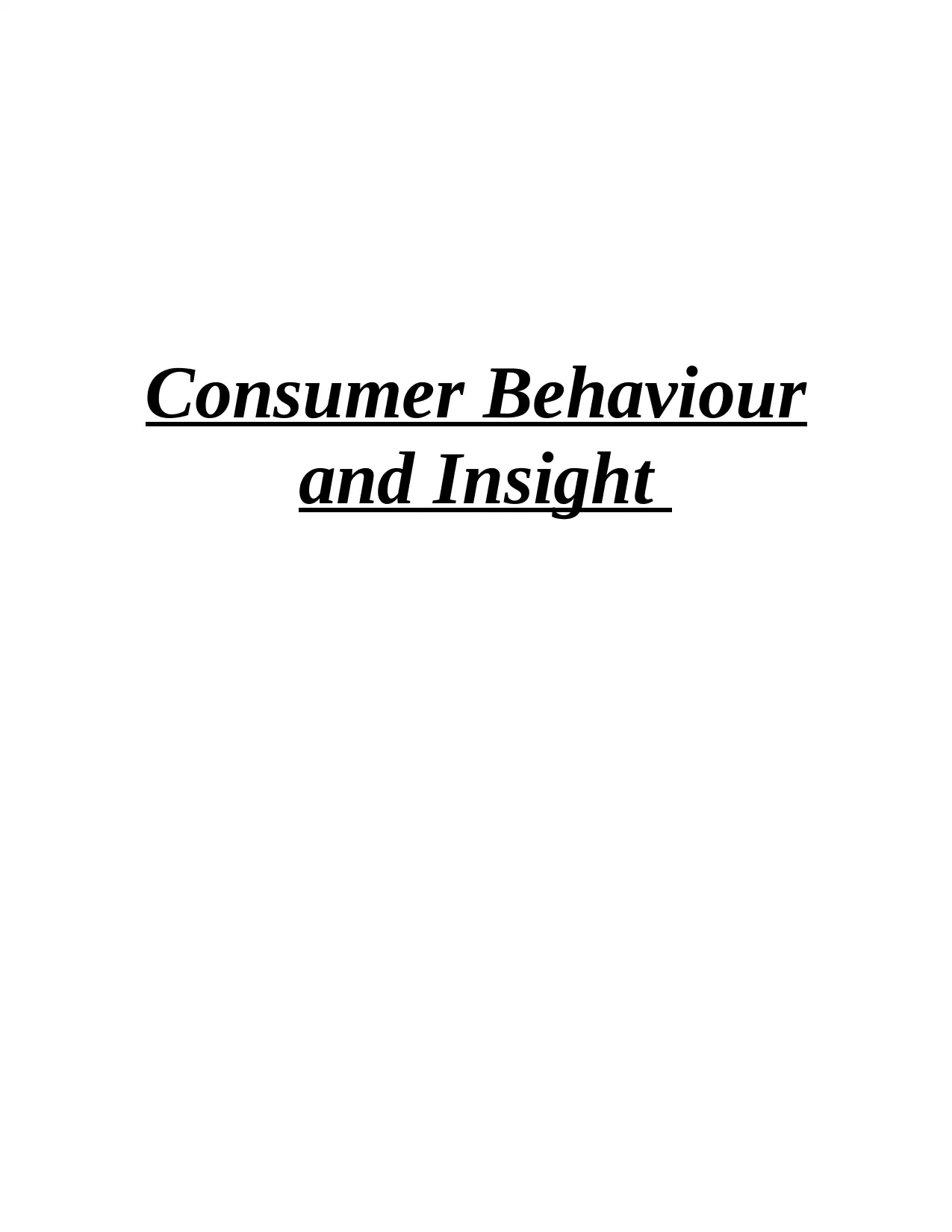
Consumer Behaviour
and Insight
and Insight
Paraphrase This Document
Need a fresh take? Get an instant paraphrase of this document with our AI Paraphraser
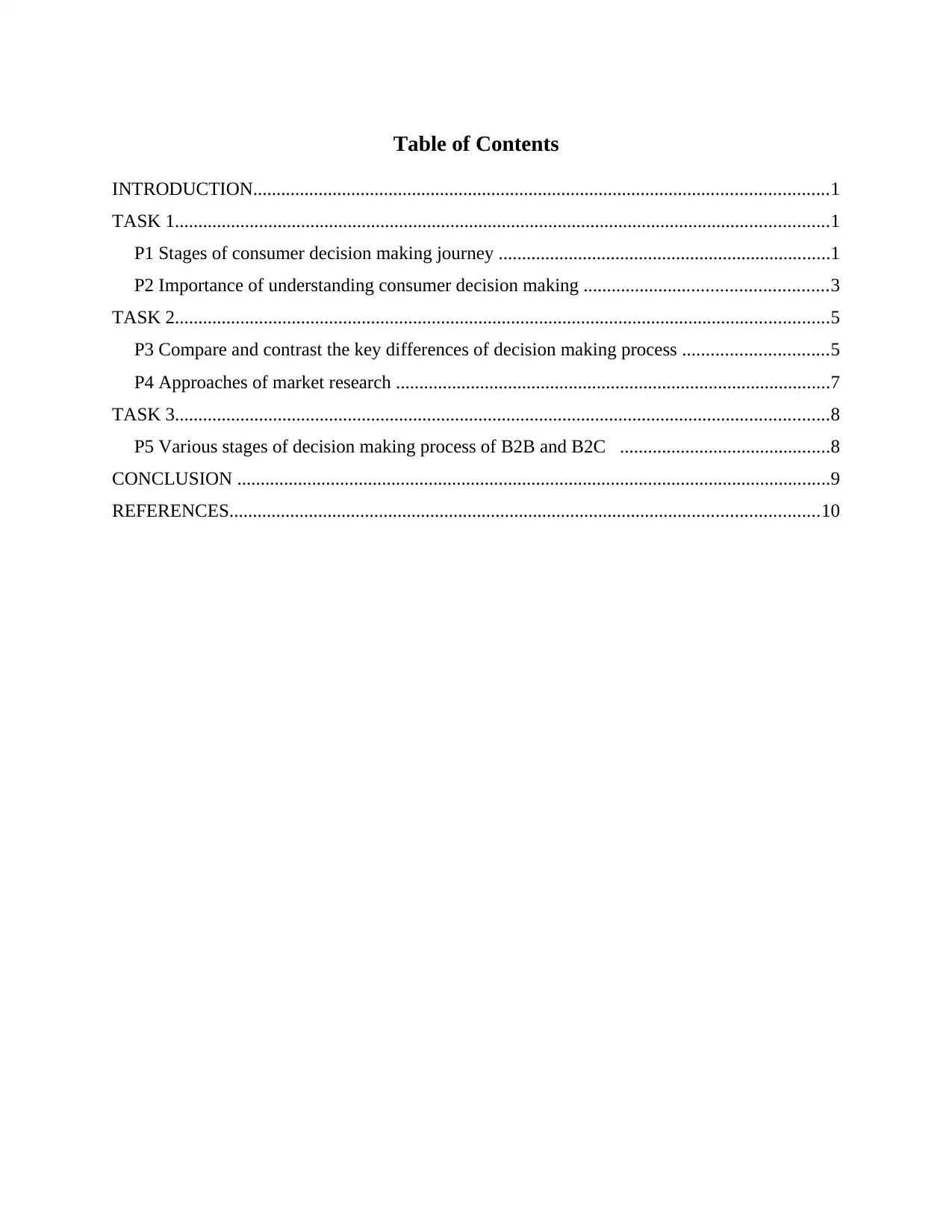
Table of Contents
INTRODUCTION...........................................................................................................................1
TASK 1............................................................................................................................................1
P1 Stages of consumer decision making journey .......................................................................1
P2 Importance of understanding consumer decision making ....................................................3
TASK 2............................................................................................................................................5
P3 Compare and contrast the key differences of decision making process ...............................5
P4 Approaches of market research .............................................................................................7
TASK 3............................................................................................................................................8
P5 Various stages of decision making process of B2B and B2C .............................................8
CONCLUSION ...............................................................................................................................9
REFERENCES..............................................................................................................................10
INTRODUCTION...........................................................................................................................1
TASK 1............................................................................................................................................1
P1 Stages of consumer decision making journey .......................................................................1
P2 Importance of understanding consumer decision making ....................................................3
TASK 2............................................................................................................................................5
P3 Compare and contrast the key differences of decision making process ...............................5
P4 Approaches of market research .............................................................................................7
TASK 3............................................................................................................................................8
P5 Various stages of decision making process of B2B and B2C .............................................8
CONCLUSION ...............................................................................................................................9
REFERENCES..............................................................................................................................10
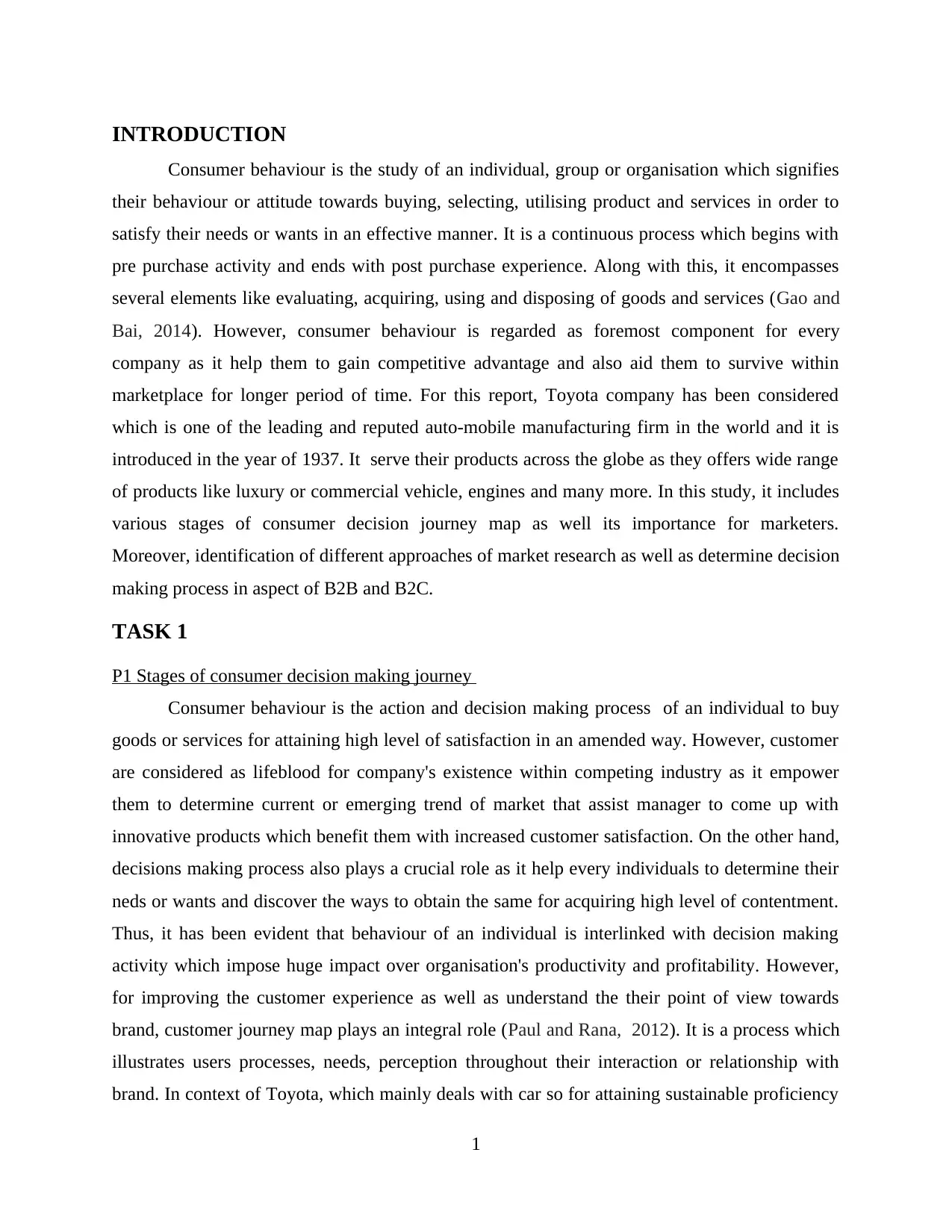
INTRODUCTION
Consumer behaviour is the study of an individual, group or organisation which signifies
their behaviour or attitude towards buying, selecting, utilising product and services in order to
satisfy their needs or wants in an effective manner. It is a continuous process which begins with
pre purchase activity and ends with post purchase experience. Along with this, it encompasses
several elements like evaluating, acquiring, using and disposing of goods and services (Gao and
Bai, 2014). However, consumer behaviour is regarded as foremost component for every
company as it help them to gain competitive advantage and also aid them to survive within
marketplace for longer period of time. For this report, Toyota company has been considered
which is one of the leading and reputed auto-mobile manufacturing firm in the world and it is
introduced in the year of 1937. It serve their products across the globe as they offers wide range
of products like luxury or commercial vehicle, engines and many more. In this study, it includes
various stages of consumer decision journey map as well its importance for marketers.
Moreover, identification of different approaches of market research as well as determine decision
making process in aspect of B2B and B2C.
TASK 1
P1 Stages of consumer decision making journey
Consumer behaviour is the action and decision making process of an individual to buy
goods or services for attaining high level of satisfaction in an amended way. However, customer
are considered as lifeblood for company's existence within competing industry as it empower
them to determine current or emerging trend of market that assist manager to come up with
innovative products which benefit them with increased customer satisfaction. On the other hand,
decisions making process also plays a crucial role as it help every individuals to determine their
neds or wants and discover the ways to obtain the same for acquiring high level of contentment.
Thus, it has been evident that behaviour of an individual is interlinked with decision making
activity which impose huge impact over organisation's productivity and profitability. However,
for improving the customer experience as well as understand the their point of view towards
brand, customer journey map plays an integral role (Paul and Rana, 2012). It is a process which
illustrates users processes, needs, perception throughout their interaction or relationship with
brand. In context of Toyota, which mainly deals with car so for attaining sustainable proficiency
1
Consumer behaviour is the study of an individual, group or organisation which signifies
their behaviour or attitude towards buying, selecting, utilising product and services in order to
satisfy their needs or wants in an effective manner. It is a continuous process which begins with
pre purchase activity and ends with post purchase experience. Along with this, it encompasses
several elements like evaluating, acquiring, using and disposing of goods and services (Gao and
Bai, 2014). However, consumer behaviour is regarded as foremost component for every
company as it help them to gain competitive advantage and also aid them to survive within
marketplace for longer period of time. For this report, Toyota company has been considered
which is one of the leading and reputed auto-mobile manufacturing firm in the world and it is
introduced in the year of 1937. It serve their products across the globe as they offers wide range
of products like luxury or commercial vehicle, engines and many more. In this study, it includes
various stages of consumer decision journey map as well its importance for marketers.
Moreover, identification of different approaches of market research as well as determine decision
making process in aspect of B2B and B2C.
TASK 1
P1 Stages of consumer decision making journey
Consumer behaviour is the action and decision making process of an individual to buy
goods or services for attaining high level of satisfaction in an amended way. However, customer
are considered as lifeblood for company's existence within competing industry as it empower
them to determine current or emerging trend of market that assist manager to come up with
innovative products which benefit them with increased customer satisfaction. On the other hand,
decisions making process also plays a crucial role as it help every individuals to determine their
neds or wants and discover the ways to obtain the same for acquiring high level of contentment.
Thus, it has been evident that behaviour of an individual is interlinked with decision making
activity which impose huge impact over organisation's productivity and profitability. However,
for improving the customer experience as well as understand the their point of view towards
brand, customer journey map plays an integral role (Paul and Rana, 2012). It is a process which
illustrates users processes, needs, perception throughout their interaction or relationship with
brand. In context of Toyota, which mainly deals with car so for attaining sustainable proficiency
1
⊘ This is a preview!⊘
Do you want full access?
Subscribe today to unlock all pages.

Trusted by 1+ million students worldwide
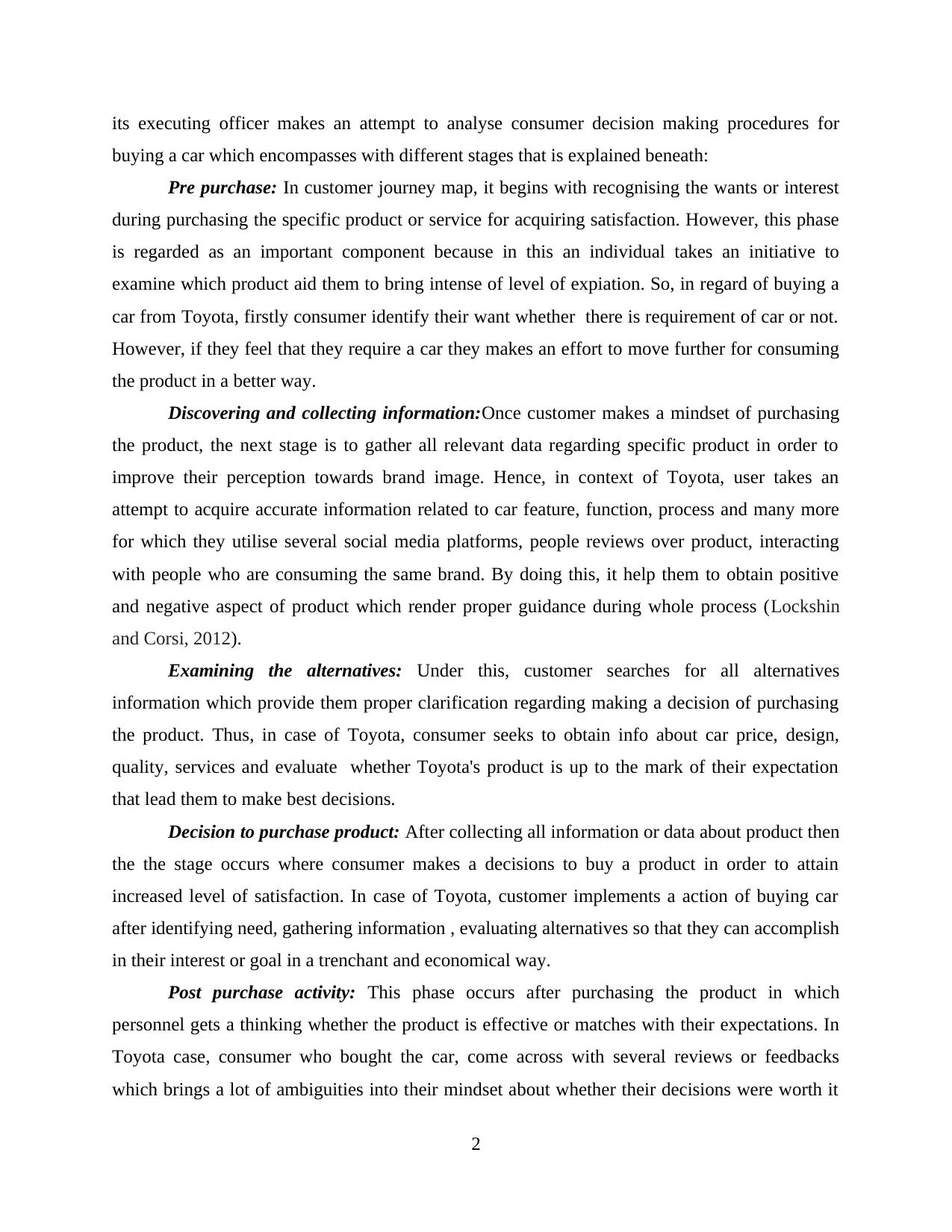
its executing officer makes an attempt to analyse consumer decision making procedures for
buying a car which encompasses with different stages that is explained beneath:
Pre purchase: In customer journey map, it begins with recognising the wants or interest
during purchasing the specific product or service for acquiring satisfaction. However, this phase
is regarded as an important component because in this an individual takes an initiative to
examine which product aid them to bring intense of level of expiation. So, in regard of buying a
car from Toyota, firstly consumer identify their want whether there is requirement of car or not.
However, if they feel that they require a car they makes an effort to move further for consuming
the product in a better way.
Discovering and collecting information:Once customer makes a mindset of purchasing
the product, the next stage is to gather all relevant data regarding specific product in order to
improve their perception towards brand image. Hence, in context of Toyota, user takes an
attempt to acquire accurate information related to car feature, function, process and many more
for which they utilise several social media platforms, people reviews over product, interacting
with people who are consuming the same brand. By doing this, it help them to obtain positive
and negative aspect of product which render proper guidance during whole process (Lockshin
and Corsi, 2012).
Examining the alternatives: Under this, customer searches for all alternatives
information which provide them proper clarification regarding making a decision of purchasing
the product. Thus, in case of Toyota, consumer seeks to obtain info about car price, design,
quality, services and evaluate whether Toyota's product is up to the mark of their expectation
that lead them to make best decisions.
Decision to purchase product: After collecting all information or data about product then
the the stage occurs where consumer makes a decisions to buy a product in order to attain
increased level of satisfaction. In case of Toyota, customer implements a action of buying car
after identifying need, gathering information , evaluating alternatives so that they can accomplish
in their interest or goal in a trenchant and economical way.
Post purchase activity: This phase occurs after purchasing the product in which
personnel gets a thinking whether the product is effective or matches with their expectations. In
Toyota case, consumer who bought the car, come across with several reviews or feedbacks
which brings a lot of ambiguities into their mindset about whether their decisions were worth it
2
buying a car which encompasses with different stages that is explained beneath:
Pre purchase: In customer journey map, it begins with recognising the wants or interest
during purchasing the specific product or service for acquiring satisfaction. However, this phase
is regarded as an important component because in this an individual takes an initiative to
examine which product aid them to bring intense of level of expiation. So, in regard of buying a
car from Toyota, firstly consumer identify their want whether there is requirement of car or not.
However, if they feel that they require a car they makes an effort to move further for consuming
the product in a better way.
Discovering and collecting information:Once customer makes a mindset of purchasing
the product, the next stage is to gather all relevant data regarding specific product in order to
improve their perception towards brand image. Hence, in context of Toyota, user takes an
attempt to acquire accurate information related to car feature, function, process and many more
for which they utilise several social media platforms, people reviews over product, interacting
with people who are consuming the same brand. By doing this, it help them to obtain positive
and negative aspect of product which render proper guidance during whole process (Lockshin
and Corsi, 2012).
Examining the alternatives: Under this, customer searches for all alternatives
information which provide them proper clarification regarding making a decision of purchasing
the product. Thus, in case of Toyota, consumer seeks to obtain info about car price, design,
quality, services and evaluate whether Toyota's product is up to the mark of their expectation
that lead them to make best decisions.
Decision to purchase product: After collecting all information or data about product then
the the stage occurs where consumer makes a decisions to buy a product in order to attain
increased level of satisfaction. In case of Toyota, customer implements a action of buying car
after identifying need, gathering information , evaluating alternatives so that they can accomplish
in their interest or goal in a trenchant and economical way.
Post purchase activity: This phase occurs after purchasing the product in which
personnel gets a thinking whether the product is effective or matches with their expectations. In
Toyota case, consumer who bought the car, come across with several reviews or feedbacks
which brings a lot of ambiguities into their mindset about whether their decisions were worth it
2
Paraphrase This Document
Need a fresh take? Get an instant paraphrase of this document with our AI Paraphraser
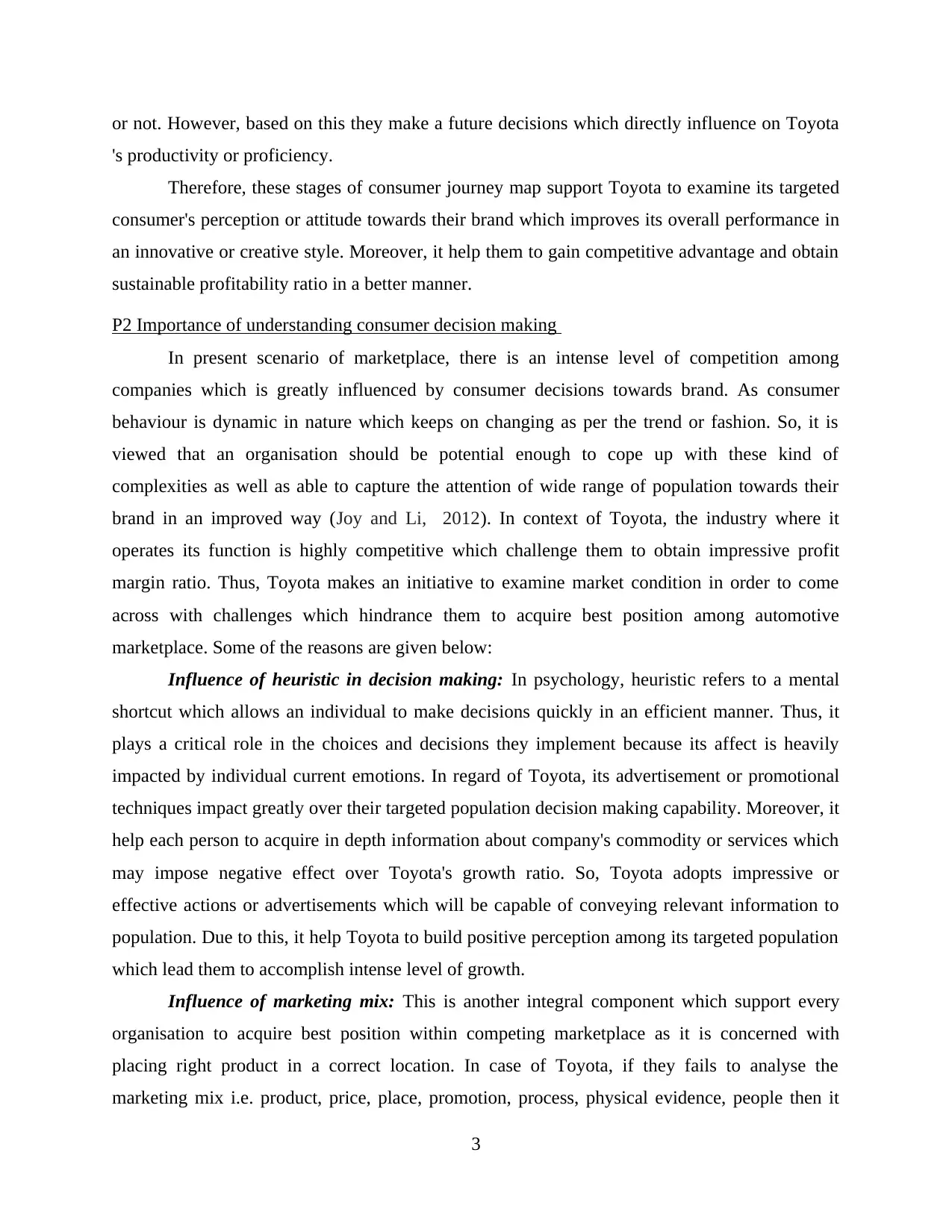
or not. However, based on this they make a future decisions which directly influence on Toyota
's productivity or proficiency.
Therefore, these stages of consumer journey map support Toyota to examine its targeted
consumer's perception or attitude towards their brand which improves its overall performance in
an innovative or creative style. Moreover, it help them to gain competitive advantage and obtain
sustainable profitability ratio in a better manner.
P2 Importance of understanding consumer decision making
In present scenario of marketplace, there is an intense level of competition among
companies which is greatly influenced by consumer decisions towards brand. As consumer
behaviour is dynamic in nature which keeps on changing as per the trend or fashion. So, it is
viewed that an organisation should be potential enough to cope up with these kind of
complexities as well as able to capture the attention of wide range of population towards their
brand in an improved way (Joy and Li, 2012). In context of Toyota, the industry where it
operates its function is highly competitive which challenge them to obtain impressive profit
margin ratio. Thus, Toyota makes an initiative to examine market condition in order to come
across with challenges which hindrance them to acquire best position among automotive
marketplace. Some of the reasons are given below:
Influence of heuristic in decision making: In psychology, heuristic refers to a mental
shortcut which allows an individual to make decisions quickly in an efficient manner. Thus, it
plays a critical role in the choices and decisions they implement because its affect is heavily
impacted by individual current emotions. In regard of Toyota, its advertisement or promotional
techniques impact greatly over their targeted population decision making capability. Moreover, it
help each person to acquire in depth information about company's commodity or services which
may impose negative effect over Toyota's growth ratio. So, Toyota adopts impressive or
effective actions or advertisements which will be capable of conveying relevant information to
population. Due to this, it help Toyota to build positive perception among its targeted population
which lead them to accomplish intense level of growth.
Influence of marketing mix: This is another integral component which support every
organisation to acquire best position within competing marketplace as it is concerned with
placing right product in a correct location. In case of Toyota, if they fails to analyse the
marketing mix i.e. product, price, place, promotion, process, physical evidence, people then it
3
's productivity or proficiency.
Therefore, these stages of consumer journey map support Toyota to examine its targeted
consumer's perception or attitude towards their brand which improves its overall performance in
an innovative or creative style. Moreover, it help them to gain competitive advantage and obtain
sustainable profitability ratio in a better manner.
P2 Importance of understanding consumer decision making
In present scenario of marketplace, there is an intense level of competition among
companies which is greatly influenced by consumer decisions towards brand. As consumer
behaviour is dynamic in nature which keeps on changing as per the trend or fashion. So, it is
viewed that an organisation should be potential enough to cope up with these kind of
complexities as well as able to capture the attention of wide range of population towards their
brand in an improved way (Joy and Li, 2012). In context of Toyota, the industry where it
operates its function is highly competitive which challenge them to obtain impressive profit
margin ratio. Thus, Toyota makes an initiative to examine market condition in order to come
across with challenges which hindrance them to acquire best position among automotive
marketplace. Some of the reasons are given below:
Influence of heuristic in decision making: In psychology, heuristic refers to a mental
shortcut which allows an individual to make decisions quickly in an efficient manner. Thus, it
plays a critical role in the choices and decisions they implement because its affect is heavily
impacted by individual current emotions. In regard of Toyota, its advertisement or promotional
techniques impact greatly over their targeted population decision making capability. Moreover, it
help each person to acquire in depth information about company's commodity or services which
may impose negative effect over Toyota's growth ratio. So, Toyota adopts impressive or
effective actions or advertisements which will be capable of conveying relevant information to
population. Due to this, it help Toyota to build positive perception among its targeted population
which lead them to accomplish intense level of growth.
Influence of marketing mix: This is another integral component which support every
organisation to acquire best position within competing marketplace as it is concerned with
placing right product in a correct location. In case of Toyota, if they fails to analyse the
marketing mix i.e. product, price, place, promotion, process, physical evidence, people then it
3
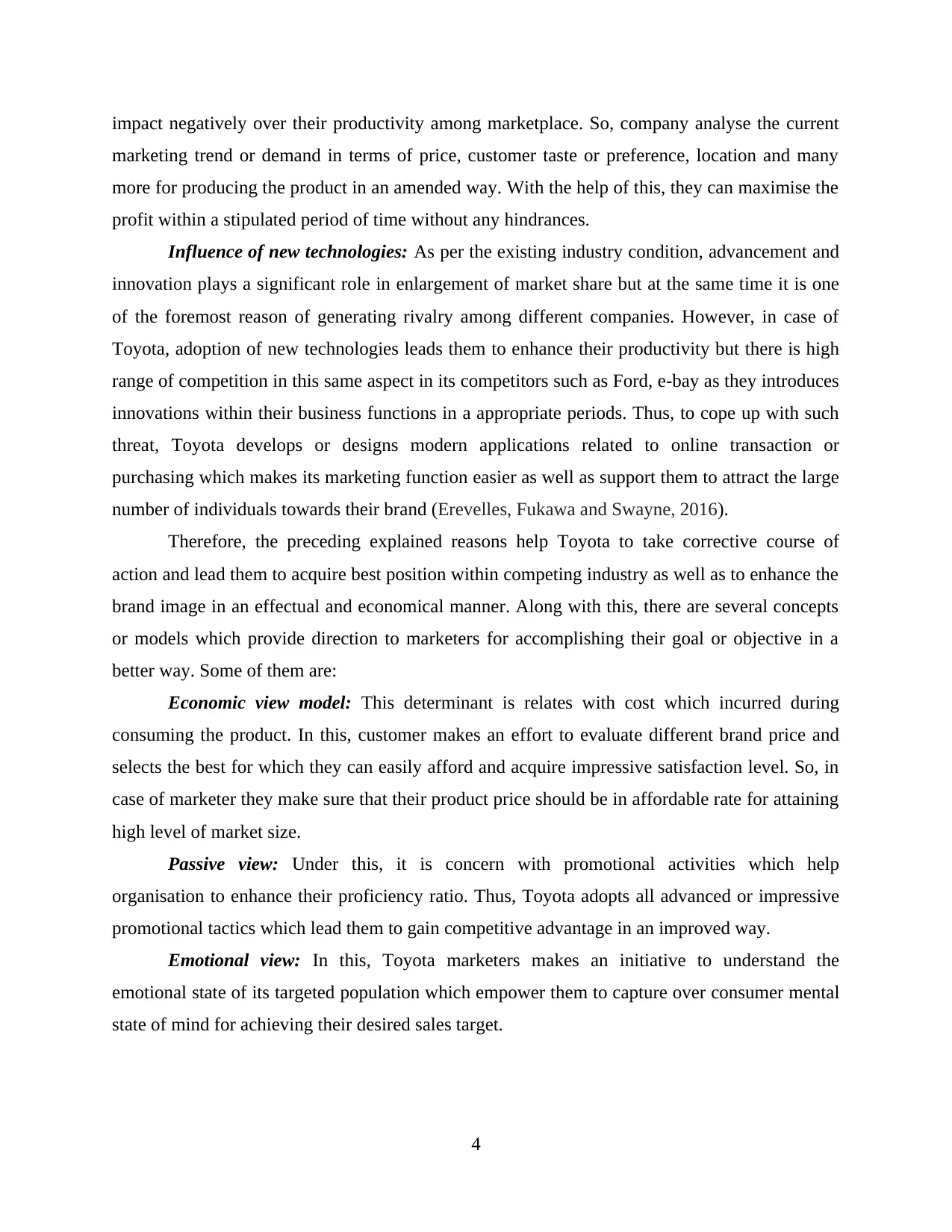
impact negatively over their productivity among marketplace. So, company analyse the current
marketing trend or demand in terms of price, customer taste or preference, location and many
more for producing the product in an amended way. With the help of this, they can maximise the
profit within a stipulated period of time without any hindrances.
Influence of new technologies: As per the existing industry condition, advancement and
innovation plays a significant role in enlargement of market share but at the same time it is one
of the foremost reason of generating rivalry among different companies. However, in case of
Toyota, adoption of new technologies leads them to enhance their productivity but there is high
range of competition in this same aspect in its competitors such as Ford, e-bay as they introduces
innovations within their business functions in a appropriate periods. Thus, to cope up with such
threat, Toyota develops or designs modern applications related to online transaction or
purchasing which makes its marketing function easier as well as support them to attract the large
number of individuals towards their brand (Erevelles, Fukawa and Swayne, 2016).
Therefore, the preceding explained reasons help Toyota to take corrective course of
action and lead them to acquire best position within competing industry as well as to enhance the
brand image in an effectual and economical manner. Along with this, there are several concepts
or models which provide direction to marketers for accomplishing their goal or objective in a
better way. Some of them are:
Economic view model: This determinant is relates with cost which incurred during
consuming the product. In this, customer makes an effort to evaluate different brand price and
selects the best for which they can easily afford and acquire impressive satisfaction level. So, in
case of marketer they make sure that their product price should be in affordable rate for attaining
high level of market size.
Passive view: Under this, it is concern with promotional activities which help
organisation to enhance their proficiency ratio. Thus, Toyota adopts all advanced or impressive
promotional tactics which lead them to gain competitive advantage in an improved way.
Emotional view: In this, Toyota marketers makes an initiative to understand the
emotional state of its targeted population which empower them to capture over consumer mental
state of mind for achieving their desired sales target.
4
marketing trend or demand in terms of price, customer taste or preference, location and many
more for producing the product in an amended way. With the help of this, they can maximise the
profit within a stipulated period of time without any hindrances.
Influence of new technologies: As per the existing industry condition, advancement and
innovation plays a significant role in enlargement of market share but at the same time it is one
of the foremost reason of generating rivalry among different companies. However, in case of
Toyota, adoption of new technologies leads them to enhance their productivity but there is high
range of competition in this same aspect in its competitors such as Ford, e-bay as they introduces
innovations within their business functions in a appropriate periods. Thus, to cope up with such
threat, Toyota develops or designs modern applications related to online transaction or
purchasing which makes its marketing function easier as well as support them to attract the large
number of individuals towards their brand (Erevelles, Fukawa and Swayne, 2016).
Therefore, the preceding explained reasons help Toyota to take corrective course of
action and lead them to acquire best position within competing industry as well as to enhance the
brand image in an effectual and economical manner. Along with this, there are several concepts
or models which provide direction to marketers for accomplishing their goal or objective in a
better way. Some of them are:
Economic view model: This determinant is relates with cost which incurred during
consuming the product. In this, customer makes an effort to evaluate different brand price and
selects the best for which they can easily afford and acquire impressive satisfaction level. So, in
case of marketer they make sure that their product price should be in affordable rate for attaining
high level of market size.
Passive view: Under this, it is concern with promotional activities which help
organisation to enhance their proficiency ratio. Thus, Toyota adopts all advanced or impressive
promotional tactics which lead them to gain competitive advantage in an improved way.
Emotional view: In this, Toyota marketers makes an initiative to understand the
emotional state of its targeted population which empower them to capture over consumer mental
state of mind for achieving their desired sales target.
4
⊘ This is a preview!⊘
Do you want full access?
Subscribe today to unlock all pages.

Trusted by 1+ million students worldwide
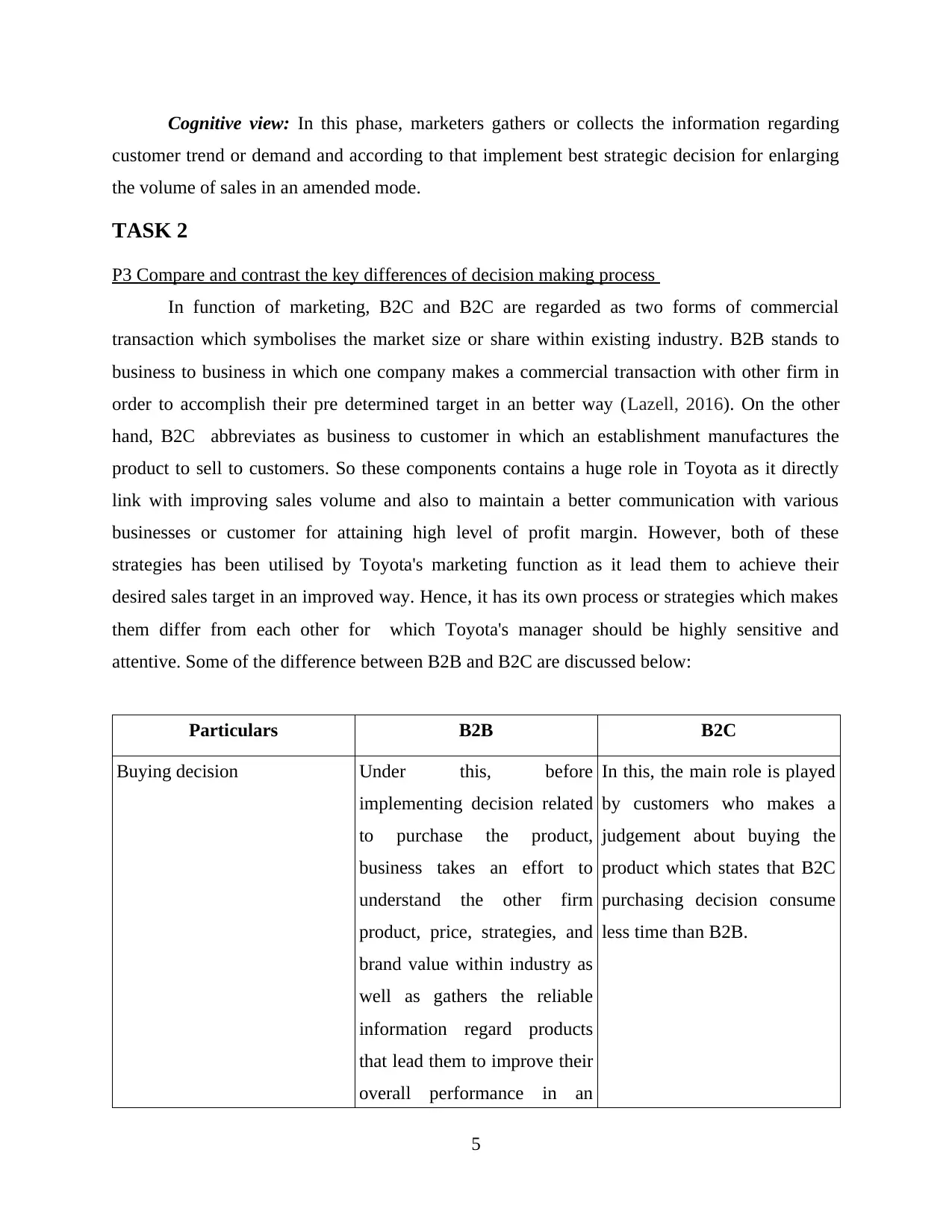
Cognitive view: In this phase, marketers gathers or collects the information regarding
customer trend or demand and according to that implement best strategic decision for enlarging
the volume of sales in an amended mode.
TASK 2
P3 Compare and contrast the key differences of decision making process
In function of marketing, B2C and B2C are regarded as two forms of commercial
transaction which symbolises the market size or share within existing industry. B2B stands to
business to business in which one company makes a commercial transaction with other firm in
order to accomplish their pre determined target in an better way (Lazell, 2016). On the other
hand, B2C abbreviates as business to customer in which an establishment manufactures the
product to sell to customers. So these components contains a huge role in Toyota as it directly
link with improving sales volume and also to maintain a better communication with various
businesses or customer for attaining high level of profit margin. However, both of these
strategies has been utilised by Toyota's marketing function as it lead them to achieve their
desired sales target in an improved way. Hence, it has its own process or strategies which makes
them differ from each other for which Toyota's manager should be highly sensitive and
attentive. Some of the difference between B2B and B2C are discussed below:
Particulars B2B B2C
Buying decision Under this, before
implementing decision related
to purchase the product,
business takes an effort to
understand the other firm
product, price, strategies, and
brand value within industry as
well as gathers the reliable
information regard products
that lead them to improve their
overall performance in an
In this, the main role is played
by customers who makes a
judgement about buying the
product which states that B2C
purchasing decision consume
less time than B2B.
5
customer trend or demand and according to that implement best strategic decision for enlarging
the volume of sales in an amended mode.
TASK 2
P3 Compare and contrast the key differences of decision making process
In function of marketing, B2C and B2C are regarded as two forms of commercial
transaction which symbolises the market size or share within existing industry. B2B stands to
business to business in which one company makes a commercial transaction with other firm in
order to accomplish their pre determined target in an better way (Lazell, 2016). On the other
hand, B2C abbreviates as business to customer in which an establishment manufactures the
product to sell to customers. So these components contains a huge role in Toyota as it directly
link with improving sales volume and also to maintain a better communication with various
businesses or customer for attaining high level of profit margin. However, both of these
strategies has been utilised by Toyota's marketing function as it lead them to achieve their
desired sales target in an improved way. Hence, it has its own process or strategies which makes
them differ from each other for which Toyota's manager should be highly sensitive and
attentive. Some of the difference between B2B and B2C are discussed below:
Particulars B2B B2C
Buying decision Under this, before
implementing decision related
to purchase the product,
business takes an effort to
understand the other firm
product, price, strategies, and
brand value within industry as
well as gathers the reliable
information regard products
that lead them to improve their
overall performance in an
In this, the main role is played
by customers who makes a
judgement about buying the
product which states that B2C
purchasing decision consume
less time than B2B.
5
Paraphrase This Document
Need a fresh take? Get an instant paraphrase of this document with our AI Paraphraser
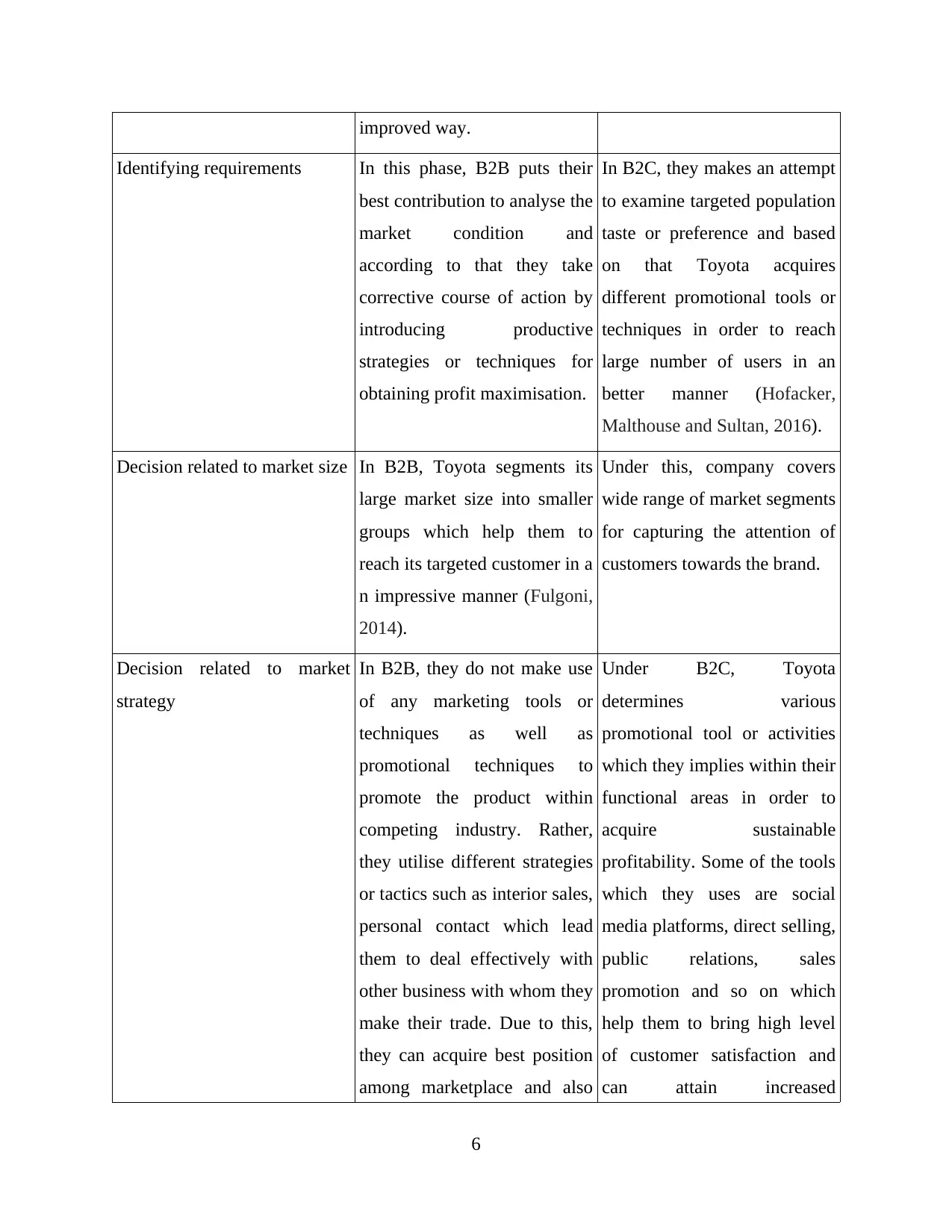
improved way.
Identifying requirements In this phase, B2B puts their
best contribution to analyse the
market condition and
according to that they take
corrective course of action by
introducing productive
strategies or techniques for
obtaining profit maximisation.
In B2C, they makes an attempt
to examine targeted population
taste or preference and based
on that Toyota acquires
different promotional tools or
techniques in order to reach
large number of users in an
better manner (Hofacker,
Malthouse and Sultan, 2016).
Decision related to market size In B2B, Toyota segments its
large market size into smaller
groups which help them to
reach its targeted customer in a
n impressive manner (Fulgoni,
2014).
Under this, company covers
wide range of market segments
for capturing the attention of
customers towards the brand.
Decision related to market
strategy
In B2B, they do not make use
of any marketing tools or
techniques as well as
promotional techniques to
promote the product within
competing industry. Rather,
they utilise different strategies
or tactics such as interior sales,
personal contact which lead
them to deal effectively with
other business with whom they
make their trade. Due to this,
they can acquire best position
among marketplace and also
Under B2C, Toyota
determines various
promotional tool or activities
which they implies within their
functional areas in order to
acquire sustainable
profitability. Some of the tools
which they uses are social
media platforms, direct selling,
public relations, sales
promotion and so on which
help them to bring high level
of customer satisfaction and
can attain increased
6
Identifying requirements In this phase, B2B puts their
best contribution to analyse the
market condition and
according to that they take
corrective course of action by
introducing productive
strategies or techniques for
obtaining profit maximisation.
In B2C, they makes an attempt
to examine targeted population
taste or preference and based
on that Toyota acquires
different promotional tools or
techniques in order to reach
large number of users in an
better manner (Hofacker,
Malthouse and Sultan, 2016).
Decision related to market size In B2B, Toyota segments its
large market size into smaller
groups which help them to
reach its targeted customer in a
n impressive manner (Fulgoni,
2014).
Under this, company covers
wide range of market segments
for capturing the attention of
customers towards the brand.
Decision related to market
strategy
In B2B, they do not make use
of any marketing tools or
techniques as well as
promotional techniques to
promote the product within
competing industry. Rather,
they utilise different strategies
or tactics such as interior sales,
personal contact which lead
them to deal effectively with
other business with whom they
make their trade. Due to this,
they can acquire best position
among marketplace and also
Under B2C, Toyota
determines various
promotional tool or activities
which they implies within their
functional areas in order to
acquire sustainable
profitability. Some of the tools
which they uses are social
media platforms, direct selling,
public relations, sales
promotion and so on which
help them to bring high level
of customer satisfaction and
can attain increased
6
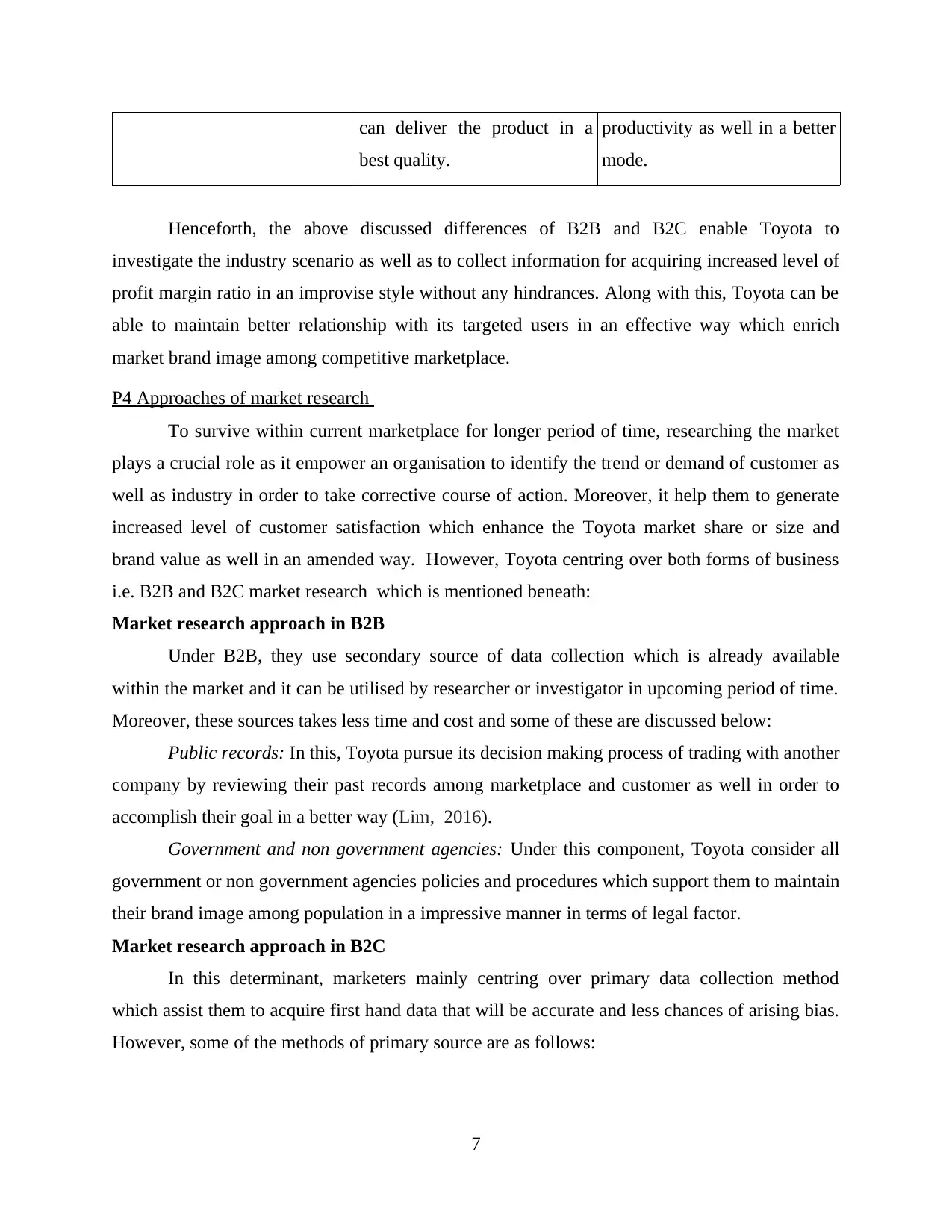
can deliver the product in a
best quality.
productivity as well in a better
mode.
Henceforth, the above discussed differences of B2B and B2C enable Toyota to
investigate the industry scenario as well as to collect information for acquiring increased level of
profit margin ratio in an improvise style without any hindrances. Along with this, Toyota can be
able to maintain better relationship with its targeted users in an effective way which enrich
market brand image among competitive marketplace.
P4 Approaches of market research
To survive within current marketplace for longer period of time, researching the market
plays a crucial role as it empower an organisation to identify the trend or demand of customer as
well as industry in order to take corrective course of action. Moreover, it help them to generate
increased level of customer satisfaction which enhance the Toyota market share or size and
brand value as well in an amended way. However, Toyota centring over both forms of business
i.e. B2B and B2C market research which is mentioned beneath:
Market research approach in B2B
Under B2B, they use secondary source of data collection which is already available
within the market and it can be utilised by researcher or investigator in upcoming period of time.
Moreover, these sources takes less time and cost and some of these are discussed below:
Public records: In this, Toyota pursue its decision making process of trading with another
company by reviewing their past records among marketplace and customer as well in order to
accomplish their goal in a better way (Lim, 2016).
Government and non government agencies: Under this component, Toyota consider all
government or non government agencies policies and procedures which support them to maintain
their brand image among population in a impressive manner in terms of legal factor.
Market research approach in B2C
In this determinant, marketers mainly centring over primary data collection method
which assist them to acquire first hand data that will be accurate and less chances of arising bias.
However, some of the methods of primary source are as follows:
7
best quality.
productivity as well in a better
mode.
Henceforth, the above discussed differences of B2B and B2C enable Toyota to
investigate the industry scenario as well as to collect information for acquiring increased level of
profit margin ratio in an improvise style without any hindrances. Along with this, Toyota can be
able to maintain better relationship with its targeted users in an effective way which enrich
market brand image among competitive marketplace.
P4 Approaches of market research
To survive within current marketplace for longer period of time, researching the market
plays a crucial role as it empower an organisation to identify the trend or demand of customer as
well as industry in order to take corrective course of action. Moreover, it help them to generate
increased level of customer satisfaction which enhance the Toyota market share or size and
brand value as well in an amended way. However, Toyota centring over both forms of business
i.e. B2B and B2C market research which is mentioned beneath:
Market research approach in B2B
Under B2B, they use secondary source of data collection which is already available
within the market and it can be utilised by researcher or investigator in upcoming period of time.
Moreover, these sources takes less time and cost and some of these are discussed below:
Public records: In this, Toyota pursue its decision making process of trading with another
company by reviewing their past records among marketplace and customer as well in order to
accomplish their goal in a better way (Lim, 2016).
Government and non government agencies: Under this component, Toyota consider all
government or non government agencies policies and procedures which support them to maintain
their brand image among population in a impressive manner in terms of legal factor.
Market research approach in B2C
In this determinant, marketers mainly centring over primary data collection method
which assist them to acquire first hand data that will be accurate and less chances of arising bias.
However, some of the methods of primary source are as follows:
7
⊘ This is a preview!⊘
Do you want full access?
Subscribe today to unlock all pages.

Trusted by 1+ million students worldwide
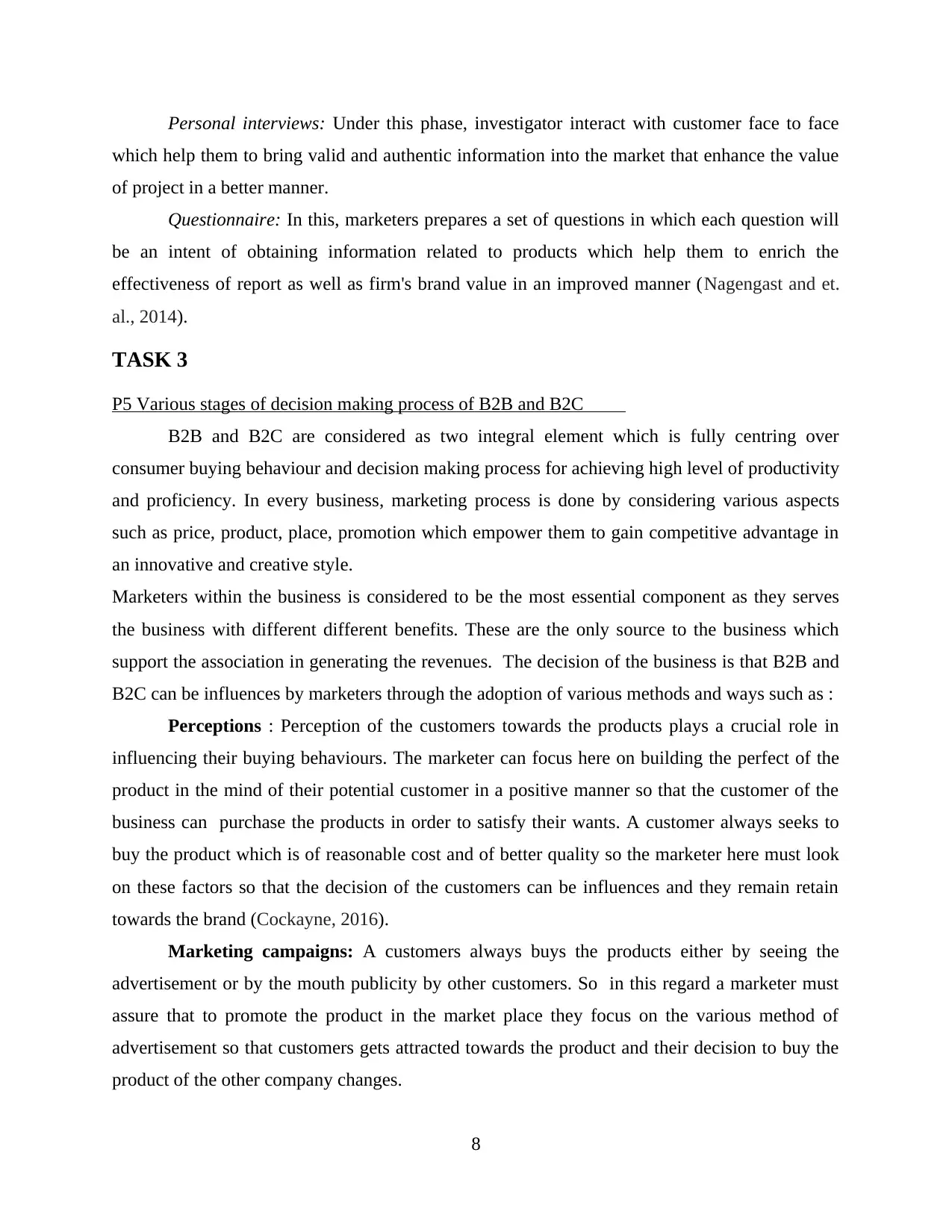
Personal interviews: Under this phase, investigator interact with customer face to face
which help them to bring valid and authentic information into the market that enhance the value
of project in a better manner.
Questionnaire: In this, marketers prepares a set of questions in which each question will
be an intent of obtaining information related to products which help them to enrich the
effectiveness of report as well as firm's brand value in an improved manner (Nagengast and et.
al., 2014).
TASK 3
P5 Various stages of decision making process of B2B and B2C
B2B and B2C are considered as two integral element which is fully centring over
consumer buying behaviour and decision making process for achieving high level of productivity
and proficiency. In every business, marketing process is done by considering various aspects
such as price, product, place, promotion which empower them to gain competitive advantage in
an innovative and creative style.
Marketers within the business is considered to be the most essential component as they serves
the business with different different benefits. These are the only source to the business which
support the association in generating the revenues. The decision of the business is that B2B and
B2C can be influences by marketers through the adoption of various methods and ways such as :
Perceptions : Perception of the customers towards the products plays a crucial role in
influencing their buying behaviours. The marketer can focus here on building the perfect of the
product in the mind of their potential customer in a positive manner so that the customer of the
business can purchase the products in order to satisfy their wants. A customer always seeks to
buy the product which is of reasonable cost and of better quality so the marketer here must look
on these factors so that the decision of the customers can be influences and they remain retain
towards the brand (Cockayne, 2016).
Marketing campaigns: A customers always buys the products either by seeing the
advertisement or by the mouth publicity by other customers. So in this regard a marketer must
assure that to promote the product in the market place they focus on the various method of
advertisement so that customers gets attracted towards the product and their decision to buy the
product of the other company changes.
8
which help them to bring valid and authentic information into the market that enhance the value
of project in a better manner.
Questionnaire: In this, marketers prepares a set of questions in which each question will
be an intent of obtaining information related to products which help them to enrich the
effectiveness of report as well as firm's brand value in an improved manner (Nagengast and et.
al., 2014).
TASK 3
P5 Various stages of decision making process of B2B and B2C
B2B and B2C are considered as two integral element which is fully centring over
consumer buying behaviour and decision making process for achieving high level of productivity
and proficiency. In every business, marketing process is done by considering various aspects
such as price, product, place, promotion which empower them to gain competitive advantage in
an innovative and creative style.
Marketers within the business is considered to be the most essential component as they serves
the business with different different benefits. These are the only source to the business which
support the association in generating the revenues. The decision of the business is that B2B and
B2C can be influences by marketers through the adoption of various methods and ways such as :
Perceptions : Perception of the customers towards the products plays a crucial role in
influencing their buying behaviours. The marketer can focus here on building the perfect of the
product in the mind of their potential customer in a positive manner so that the customer of the
business can purchase the products in order to satisfy their wants. A customer always seeks to
buy the product which is of reasonable cost and of better quality so the marketer here must look
on these factors so that the decision of the customers can be influences and they remain retain
towards the brand (Cockayne, 2016).
Marketing campaigns: A customers always buys the products either by seeing the
advertisement or by the mouth publicity by other customers. So in this regard a marketer must
assure that to promote the product in the market place they focus on the various method of
advertisement so that customers gets attracted towards the product and their decision to buy the
product of the other company changes.
8
Paraphrase This Document
Need a fresh take? Get an instant paraphrase of this document with our AI Paraphraser
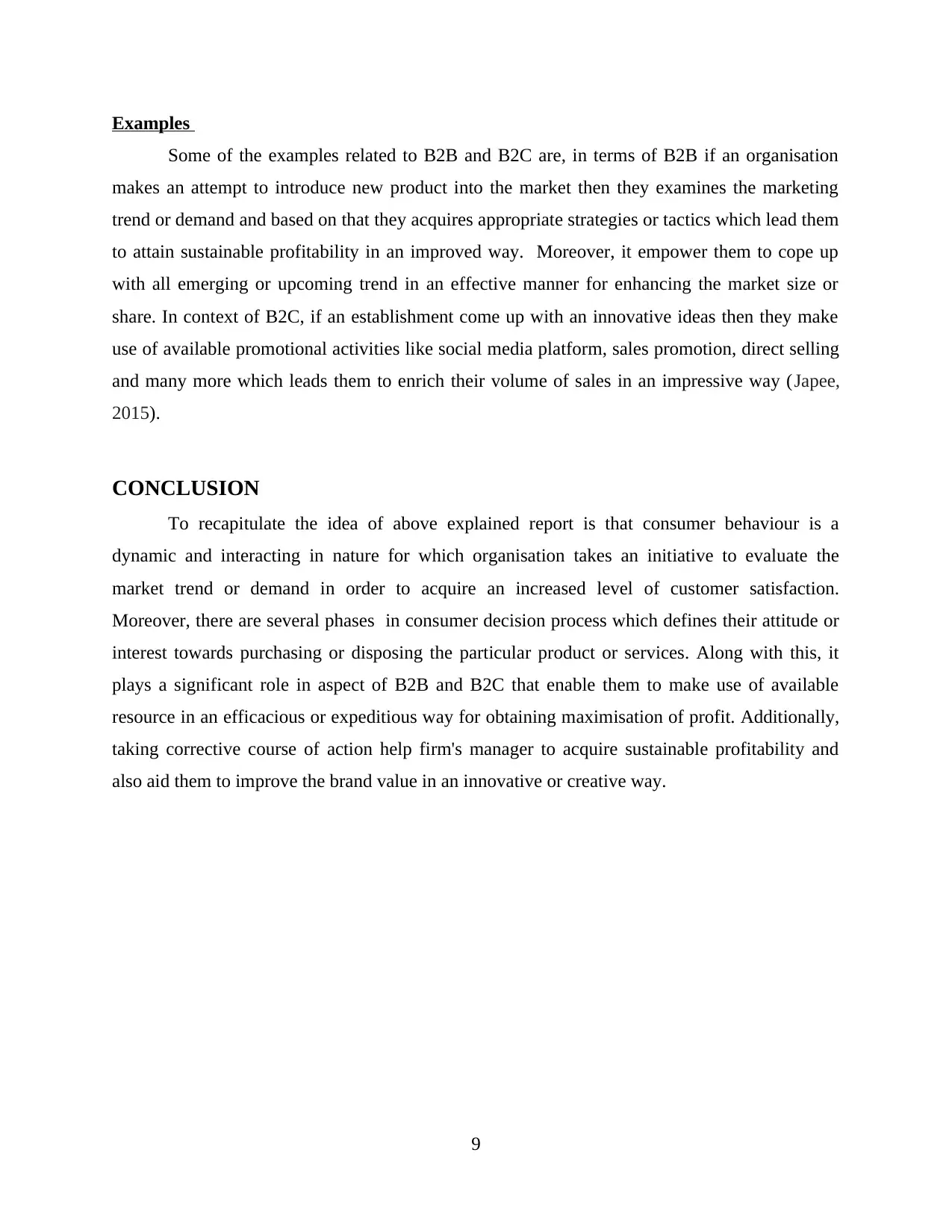
Examples
Some of the examples related to B2B and B2C are, in terms of B2B if an organisation
makes an attempt to introduce new product into the market then they examines the marketing
trend or demand and based on that they acquires appropriate strategies or tactics which lead them
to attain sustainable profitability in an improved way. Moreover, it empower them to cope up
with all emerging or upcoming trend in an effective manner for enhancing the market size or
share. In context of B2C, if an establishment come up with an innovative ideas then they make
use of available promotional activities like social media platform, sales promotion, direct selling
and many more which leads them to enrich their volume of sales in an impressive way (Japee,
2015).
CONCLUSION
To recapitulate the idea of above explained report is that consumer behaviour is a
dynamic and interacting in nature for which organisation takes an initiative to evaluate the
market trend or demand in order to acquire an increased level of customer satisfaction.
Moreover, there are several phases in consumer decision process which defines their attitude or
interest towards purchasing or disposing the particular product or services. Along with this, it
plays a significant role in aspect of B2B and B2C that enable them to make use of available
resource in an efficacious or expeditious way for obtaining maximisation of profit. Additionally,
taking corrective course of action help firm's manager to acquire sustainable profitability and
also aid them to improve the brand value in an innovative or creative way.
9
Some of the examples related to B2B and B2C are, in terms of B2B if an organisation
makes an attempt to introduce new product into the market then they examines the marketing
trend or demand and based on that they acquires appropriate strategies or tactics which lead them
to attain sustainable profitability in an improved way. Moreover, it empower them to cope up
with all emerging or upcoming trend in an effective manner for enhancing the market size or
share. In context of B2C, if an establishment come up with an innovative ideas then they make
use of available promotional activities like social media platform, sales promotion, direct selling
and many more which leads them to enrich their volume of sales in an impressive way (Japee,
2015).
CONCLUSION
To recapitulate the idea of above explained report is that consumer behaviour is a
dynamic and interacting in nature for which organisation takes an initiative to evaluate the
market trend or demand in order to acquire an increased level of customer satisfaction.
Moreover, there are several phases in consumer decision process which defines their attitude or
interest towards purchasing or disposing the particular product or services. Along with this, it
plays a significant role in aspect of B2B and B2C that enable them to make use of available
resource in an efficacious or expeditious way for obtaining maximisation of profit. Additionally,
taking corrective course of action help firm's manager to acquire sustainable profitability and
also aid them to improve the brand value in an innovative or creative way.
9
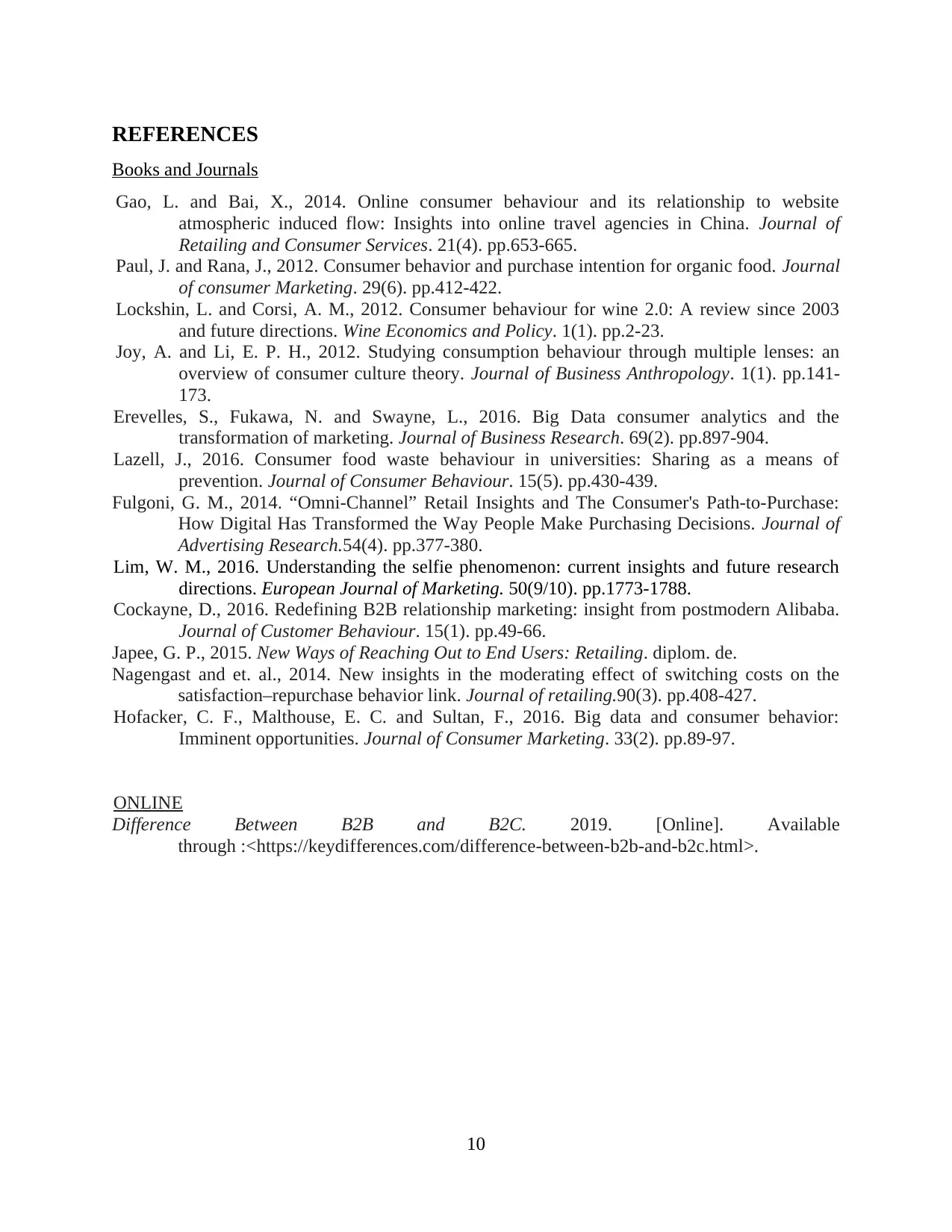
REFERENCES
Books and Journals
Gao, L. and Bai, X., 2014. Online consumer behaviour and its relationship to website
atmospheric induced flow: Insights into online travel agencies in China. Journal of
Retailing and Consumer Services. 21(4). pp.653-665.
Paul, J. and Rana, J., 2012. Consumer behavior and purchase intention for organic food. Journal
of consumer Marketing. 29(6). pp.412-422.
Lockshin, L. and Corsi, A. M., 2012. Consumer behaviour for wine 2.0: A review since 2003
and future directions. Wine Economics and Policy. 1(1). pp.2-23.
Joy, A. and Li, E. P. H., 2012. Studying consumption behaviour through multiple lenses: an
overview of consumer culture theory. Journal of Business Anthropology. 1(1). pp.141-
173.
Erevelles, S., Fukawa, N. and Swayne, L., 2016. Big Data consumer analytics and the
transformation of marketing. Journal of Business Research. 69(2). pp.897-904.
Lazell, J., 2016. Consumer food waste behaviour in universities: Sharing as a means of
prevention. Journal of Consumer Behaviour. 15(5). pp.430-439.
Fulgoni, G. M., 2014. “Omni-Channel” Retail Insights and The Consumer's Path-to-Purchase:
How Digital Has Transformed the Way People Make Purchasing Decisions. Journal of
Advertising Research.54(4). pp.377-380.
Lim, W. M., 2016. Understanding the selfie phenomenon: current insights and future research
directions. European Journal of Marketing. 50(9/10). pp.1773-1788.
Cockayne, D., 2016. Redefining B2B relationship marketing: insight from postmodern Alibaba.
Journal of Customer Behaviour. 15(1). pp.49-66.
Japee, G. P., 2015. New Ways of Reaching Out to End Users: Retailing. diplom. de.
Nagengast and et. al., 2014. New insights in the moderating effect of switching costs on the
satisfaction–repurchase behavior link. Journal of retailing.90(3). pp.408-427.
Hofacker, C. F., Malthouse, E. C. and Sultan, F., 2016. Big data and consumer behavior:
Imminent opportunities. Journal of Consumer Marketing. 33(2). pp.89-97.
ONLINE
Difference Between B2B and B2C. 2019. [Online]. Available
through :<https://keydifferences.com/difference-between-b2b-and-b2c.html>.
10
Books and Journals
Gao, L. and Bai, X., 2014. Online consumer behaviour and its relationship to website
atmospheric induced flow: Insights into online travel agencies in China. Journal of
Retailing and Consumer Services. 21(4). pp.653-665.
Paul, J. and Rana, J., 2012. Consumer behavior and purchase intention for organic food. Journal
of consumer Marketing. 29(6). pp.412-422.
Lockshin, L. and Corsi, A. M., 2012. Consumer behaviour for wine 2.0: A review since 2003
and future directions. Wine Economics and Policy. 1(1). pp.2-23.
Joy, A. and Li, E. P. H., 2012. Studying consumption behaviour through multiple lenses: an
overview of consumer culture theory. Journal of Business Anthropology. 1(1). pp.141-
173.
Erevelles, S., Fukawa, N. and Swayne, L., 2016. Big Data consumer analytics and the
transformation of marketing. Journal of Business Research. 69(2). pp.897-904.
Lazell, J., 2016. Consumer food waste behaviour in universities: Sharing as a means of
prevention. Journal of Consumer Behaviour. 15(5). pp.430-439.
Fulgoni, G. M., 2014. “Omni-Channel” Retail Insights and The Consumer's Path-to-Purchase:
How Digital Has Transformed the Way People Make Purchasing Decisions. Journal of
Advertising Research.54(4). pp.377-380.
Lim, W. M., 2016. Understanding the selfie phenomenon: current insights and future research
directions. European Journal of Marketing. 50(9/10). pp.1773-1788.
Cockayne, D., 2016. Redefining B2B relationship marketing: insight from postmodern Alibaba.
Journal of Customer Behaviour. 15(1). pp.49-66.
Japee, G. P., 2015. New Ways of Reaching Out to End Users: Retailing. diplom. de.
Nagengast and et. al., 2014. New insights in the moderating effect of switching costs on the
satisfaction–repurchase behavior link. Journal of retailing.90(3). pp.408-427.
Hofacker, C. F., Malthouse, E. C. and Sultan, F., 2016. Big data and consumer behavior:
Imminent opportunities. Journal of Consumer Marketing. 33(2). pp.89-97.
ONLINE
Difference Between B2B and B2C. 2019. [Online]. Available
through :<https://keydifferences.com/difference-between-b2b-and-b2c.html>.
10
⊘ This is a preview!⊘
Do you want full access?
Subscribe today to unlock all pages.

Trusted by 1+ million students worldwide
1 out of 12
Related Documents
Your All-in-One AI-Powered Toolkit for Academic Success.
+13062052269
info@desklib.com
Available 24*7 on WhatsApp / Email
![[object Object]](/_next/static/media/star-bottom.7253800d.svg)
Unlock your academic potential
Copyright © 2020–2025 A2Z Services. All Rights Reserved. Developed and managed by ZUCOL.





